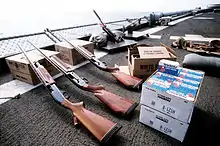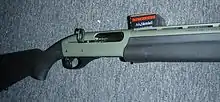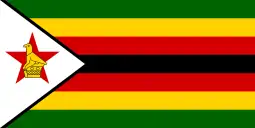Remington Model 1100
The Remington 1100 is a gas-operated semi-automatic shotgun, popular among sportsmen. First introduced by Remington Arms in 1963, it remains in contemporary production, 58 years later.
| Remington 1100 | |
|---|---|
 Remington 1100 Tactical Shotgun in 12 gauge—holds eight rounds (23⁄4") in the magazine | |
| Type | Semi-automatic shotgun |
| Place of origin | United States |
| Service history | |
| Used by | See Users |
| Production history | |
| Designer | Wayne Leek & Robert Kelley |
| Manufacturer | Remington Arms |
| Produced | 1963–present |
| Specifications | |
| Mass | 8 lb (3.6 kg) (28" barrel) |
| Length | Varies with model |
| Barrel length | 18 to 30 inches (460 to 760 mm) |
| Cartridge | 12, 16, 20, and 28 gauge, and .410 bore |
| Action | Semi-automatic, gas-operated |
| Feed system | 4 to 8 round tube magazine |
| References | [1] |
History
Designed by Wayne Leek and Robert Kelley,[2][3] the Remington Model 1100 was introduced in 1963 as a successor to the Model 58 and Model 878 gas operated shotguns.[4] The Model 58 had supplemented the recoil operated Model 11-48, which retained the long recoil action of John Browning's original design, present in the Model 11 and the Browning Auto-5. Upon its introduction in 1963, the Model 1100 replaced the Model 58 and Model 878, and later replaced the Model 11-48 as well.
The Model 1100 ushered in the era of successful and reliable gas-actuated autoloading shotguns; all models of the series are gas operated with a mechanism that noticeably reduces recoil.[4] As of 1983, it was the best selling autoloading shotgun in U.S. history, in dollar terms.[4]
A plain version of the Model 1100 in 12 gauge, named the Sportsman 12 Auto, was sold in stores such as Target, Kmart, and Walmart in the mid-1980s, along with the Sportsman 12 Pump, which was a plain Model 870. The Sportsman 12 Auto had less costly birch stocks and less rollmarking on the gun's receiver. These were simply cosmetic differences, and all Model 1100 parts in 12 gauge are fully interchangeable, including barrels and receivers. Both Sportsman 12 offerings were discontinued in 1987, concurrent with the introduction of the semi-automatic Model 11-87 and the pump action Model 870 Express.
In 2011, Remington introduced the Model 1100 Competition Synthetic. A 50th Anniversary highly decorated version was introduced in 2013. Over four million Model 1100 shotguns have been produced. Several variations of the series—in 12, 20, and 28 gauges, and .410 bore—remain in contemporary production.[5][6]
Design

The Model 1100 bleeds off gases to operate the action through ports in the barrel near the fore end. The gasses then drive a steel action sleeve that fits around the magazine tube and connects to the bolt carrier to the rear, ejecting the spent shell. A fresh shell is released from the magazine, which trips the carrier release, and the action spring in the stock pushes the bolt forward, picking up the fresh shell and loading it into the chamber. With modifications to the trigger group to regulate feed and firing, the design is basically a gas powered Model 870.
The design team spent many hundreds of hours test firing and getting input from shooters on the design before it was released for production. The fact that plastic shotshells had come onto the scene, and even the older paper shells were carrying improved coatings, made for more reliable ammunition, which no doubt assisted the Model 1100 to become a true breakthrough in gas operated shotgun reliability. The design was self-compensating to an extent not seen previously, in that any 2 3⁄4-inch (7.0 cm) shell could be fired without adjustment in the standard models, and both 2 3⁄4 and 3-inch (7.6 cm) Magnum shells could be used interchangeably on the Magnum versions.
The Model 1100's carrier release is located on the underside of the firearm,[1] which is unlike a number of other semi-automatic shotguns such as the Mossberg 930 or the FN SLP whose carrier releases are located on the side.[7][8]
Use
The 1100 is a popular gun used in trap shooting, skeet shooting, and sporting clays; and special versions with high ribs and Monte Carlo stocks are available. The Competition Synthetic model with an adjustable carbon fibre stock set was introduced in 2012 and has been received quite favorably. As with other semi-automatic shotguns, a shell catcher can be used to avoid spent shells hitting others on the squad when shooting trap. Modified versions of the 1100 are popular in multigun practical shooting events.
Model introduction

- 1963: 12 gauge
- 1964: 16 gauge
- 1964: 20 gauge
- 1969: .410 bore
- 1970: Matched Pair in .410 bore and 28 gauge
- 1970: 20 gauge Lightweight—LW
- 1977: 20 gauge Lightweight—LT
Through the years, there have been numerous limited editions and commemorative models.
Nighthawk Custom offers a customized version of the Remington 1100 for police use, home defense, and competition shooting.[9]
Users
.svg.png.webp) Australia[10]
Australia[10] Bangladesh
Bangladesh.svg.png.webp) Belgium
Belgium Benin[10]
Benin[10] Bolivia
Bolivia Brazil: Used by Military Police of Rio de Janeiro State.
Brazil: Used by Military Police of Rio de Janeiro State. Cambodia
Cambodia.svg.png.webp) Canada: Used by Edmonton Police Service.
Canada: Used by Edmonton Police Service.  Colombia
Colombia Democratic Republic of the Congo
Democratic Republic of the Congo Dominican Republic
Dominican Republic Estonia
Estonia Guatemala
Guatemala Israel
Israel Kyrgyzstan
Kyrgyzstan Malaysia: National Special Operations Force.[11]
Malaysia: National Special Operations Force.[11] Malta[10]
Malta[10] Mexico: Used by Mexican Naval Infantry.
Mexico: Used by Mexican Naval Infantry. Mozambique
Mozambique Nepal
Nepal New Zealand[10]
New Zealand[10] Oman
Oman Pakistan
Pakistan Panama[10]
Panama[10] Tanzania
Tanzania Thailand[10]
Thailand[10] Tunisia
Tunisia Turkey
Turkey Uganda
Uganda United States: Used by some law enforcement agencies.[10]
United States: Used by some law enforcement agencies.[10] Venezuela
Venezuela Vietnam
Vietnam Yemen
Yemen Zambia
Zambia Zimbabwe
Zimbabwe
References
- "Instruction Book for: Models 1100, 11-87 & 11-87 Super Magnum Autoloading Shotguns" (PDF). Remington Arms. Retrieved June 5, 2020 – via remington.com. Cite magazine requires
|magazine=(help) - "Remington 1100". Gun Collections Online. Retrieved June 6, 2020.
- Lawrence, Chris (July 26, 2013). "All hail the Remington 1100". wvmetronews.com. Retrieved June 6, 2020.
- Wallack, LR. "Sixty Million Guns". 1983. In Gun Digest Treasury, Harold A. Murtz, editor, DBI Books. 1994 p.193 ISBN 0873491564
- "The Model 1100". remington.com. Retrieved June 6, 2020.
- "Model 1100 Sporting Series". remington.com. Retrieved June 6, 2020.
- "Owner's Manual: 930 and 935 Autoloading Shotgun" (PDF). North Haven, Connecticut: O.F. Mossberg & Sons. Retrieved June 6, 2020 – via mossberg.com.
- "SLP: Autoloading Shotgun Owner's Manual" (PDF). fnhusa.com. Archived from the original (PDF) on 2012-09-04. Retrieved 2012-09-07 – via Wayback Machine.
- Pridgen, D.K. (2010). "Nighthawk Tactical 1100 12 Gauge". Guns & Weapons for Law Enforcement. 19 (10): 98.
- McManners, Hugh (2003). Ultimate Special Forces. DK Publishing, Inc. ISBN 0-7894-9973-8.
- Thompson, Leroy (December 2008). "Malaysian Special Forces". Special Weapons. Retrieved 2010-02-10.
Further reading
| Wikimedia Commons has media related to Remington Model 1100. |
- How to clean the Model 1100 from Shotgun World
- Collecting Model 1100 Shotguns from Remington Society